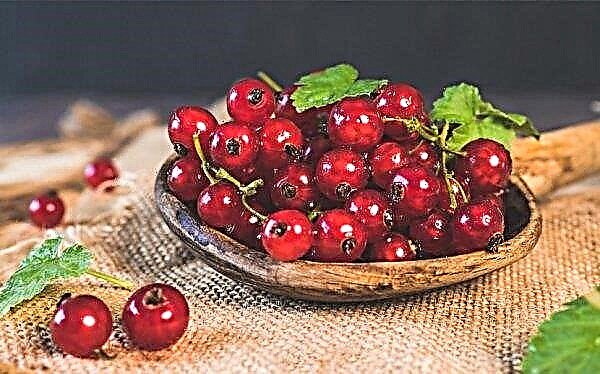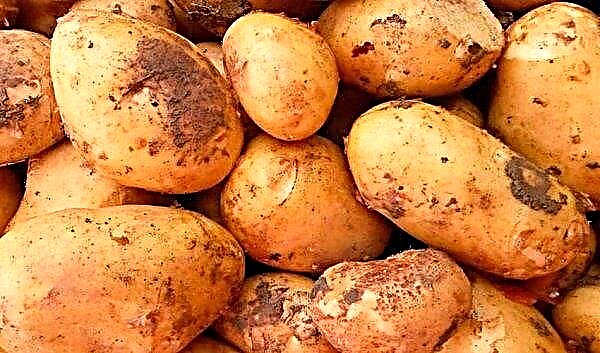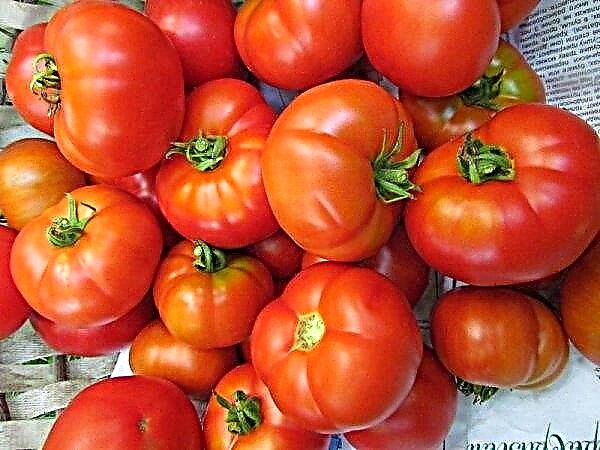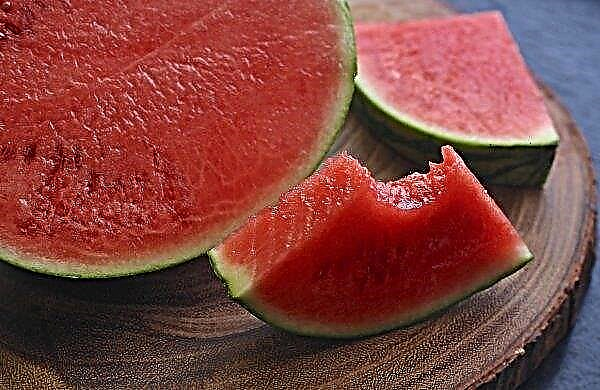Hydrangea is often used to design garden plots. There are different types of this beautifully flowering bush - paniculate, tree-like, large-leaved. The specified plant culture is quite unpretentious in care and will decorate any garden. Sometimes hydrangeas can notice phenomena such as drying and darkening of foliage. In this case, it is necessary to take a series of actions as soon as possible to eliminate the problem.
Why do hydrangea leaves turn dark and dry
First of all, you need to find out why the leaves began to darken or blacken, dry out. This is especially noticeable on large-leaf varieties of hydrangea.
Did you know? The British first met hydrangea in 1789, when it was brought in from China by the botanist Joseph Banks.
Drying and darkening of foliage can cause the following factors:
- excessive irrigation, stagnation of water in the soil;
- unsuitable soil;
- drafts, jumps in air temperature;
- sunburn;
- lack of nutrients;
- the appearance of certain diseases and pests.
 It is important to notice the cause in a timely manner and take measures to eliminate it.
It is important to notice the cause in a timely manner and take measures to eliminate it.
What to do and how to treat
Treatment for hydrangea depends on the identified cause of the foliage. In any case, the plant should begin to be properly looked after so that it grows stronger, especially since errors in the care often lead to a poor state of hydrangea. If hydrangea is sick or is being attacked by pests, appropriate treatments must be done.
Proper care
Well-established hydrangea care helps to avoid many problems with this shrub.
Professional gardeners recommend adhering to the following rules:
- Planting seedlings in partial shade. Too hot direct rays of the sun can cause the leaves to dry out. The best option would be when there is a shadow before noon, and after lunch time the sun appears. It should also be ensured that the hydrangea area is well protected from drafts.
- Proper watering. Under 1 adult specimen on a hot day, pour 20 liters of water under the root. Do not sprinkle, as this can cause sunburn. In rainy weather, watering is stopped. Excessive moisture is also unacceptable.
- The landing area should have the required acidity level (pH 5.5). If it is low, then this negatively affects the plant: the inflorescences of blue and blue varieties will not turn blue, but will become pink or white. Watering with the addition of citric acid will help increase the level of acidity in the earth.
- The soil at the place of hydrangea growth should be nutritious and moisture permeable. With dense soil, water stagnates. For looseness, even when planting a bush, drainage is made at the bottom of the landing pit, and humus and sand are added to the soil.
- Conduct recommended dressings to strengthen the crop. For this, organic and mineral fertilizers are used. You can buy ready-made mixes for these flowering bushes in the garden store.
- Crop for fall, mulch the area around the bushes and protect the shelter from winter frosts.
- To do preventive spraying in the spring against pests and diseases.

When caring for the bushes, you need to pay attention to the appearance of such factors that subsequently lead to darkening of the leaves:
- redness of the leaves indicates a low level of acidity in the soil, as well as a lack of micronutrients (phosphorus);
- drying of the ends of the leaf plate indicates a lack of moisture in the soil and the need for potash fertilizers;
- yellowing of the leaves indicates drafts, jumps in air temperature, lack of nutrients (iron);
- wet blackening of foliage occurs in the event of waterlogging or stagnation of water, temperature differences.

Treatment of common leaf diseases
Improper care weakens the plant and can cause various diseases that can cause the leaves to turn black. Most often, the cause of the appearance of fungi is waterlogging. In this case, it is important to identify the problem in a timely manner and take measures to eliminate it. The following are the main hydrangea diseases and how to eliminate them.
Important! For the prevention of viral diseases, it is worthwhile to feed, increasing the immunity of the plant, as well as spraying from the appearance of various pests.
Powdery mildew
When such a fungal disease appears, yellow-green spots appear on the foliage, and then a grayish powdery coating becomes noticeable in the lower part of the bush. Shoots undergo deformation and dry. To eliminate this problem, fungicidal preparations such as Fitosporin, Topaz, and Skor are treated.

Peronosporosis
The reason for the appearance of this disease is increased humidity at an air temperature of + 17 ... + 20 ° C. Greasy spots appear on the leaf plates, which turn black over time. It is necessary to carry out the treatment of the shrub with the help of such a solution: 250 g of grated laundry soap and 15 g of copper sulfate are diluted in a 10-liter bucket. You can use other copper-containing drugs.

White rot
This fungal disease absorbs many of the nutrients needed for hydrangea. The causes of the disease are plant residues, neighboring plants, excess moisture. White rot can be detected by decay and darkening of shoots near the ground, as well as a whitish cotton-like coating on the leaves: it darkens over time, and the leaves and color fall off. If the disease affects the bush too much, it is better to dig and dispose of it so as not to infect neighboring crops.
 If the disease is detected at the initial stage, it is necessary to remove the affected areas, and rinse the sections with a solution of potassium permanganate. It is also necessary to spray with fungicidal preparations - copper sulfate, Bordeaux liquid, Fundazol.
If the disease is detected at the initial stage, it is necessary to remove the affected areas, and rinse the sections with a solution of potassium permanganate. It is also necessary to spray with fungicidal preparations - copper sulfate, Bordeaux liquid, Fundazol.
Gray rot
When this fungal disease is affected, leaves and shoots lose their density, soften and become watery. In hot weather, when they dry out, cavities form due to the activity of fungal microorganisms. Often the disease appears due to excessive waterlogging. Damaged areas should be cut off and disposed of (burned). It is obligatory to carry out the treatment with Fundazolum or another fungicide. For spraying indoor varieties, it is better to use the preparations "Chistotsvet" or "Skor".

Fusariosis (tracheomycosis)
Infection with this fungal disease often occurs through the soil, the remains of vegetation. Fungi provoke the process of withering of the plant - green leaves begin to turn yellow, then darken and die off, the buds also crumble. In the initial stages, you can save the bushes by spraying with infusion of nettle and celandine. The fungicidal preparations "Fundazol", "Topsin" help well.

Septoria
Septoria can be seen by the brown spots that appeared on the leaf blades, which are darker at the edges. Leaves and shoots gradually begin to die. Affected areas should be removed and burned, the places of cuts should be treated with garden var or a solution of manganese.
Important! Septoria can quickly affect other plants - apple trees, eggplant, raspberry bushes, asters, phloxes and so on. For this reason, when it is detected, preventive treatment of neighboring plants should be carried out.
At the first signs, spraying with a solution of copper sulfate, Bordeaux mixture or other copper-containing preparations should be carried out. Processing large areas should be done using a special sprayer.

Rust
Often the causes of this fungal disease are excess moisture and excess nitrogen in the soil. Rust can be detected by the appearance of yellow-orange growths on leaves that die and fall off. In this case, it is necessary to remove the affected areas and spray with copper chloride (20 g per 5 l of liquid) or Topaz, Falcon.

Wet and dry blackening
Dry darkening manifests itself in the form of dry dark brown spots on the sheets, which then die and fall off. The main factors that cause this problem are sunburn, improper care, and unsuitable soil for planting.
Wet darkening can be detected on leaf blades in the form of black wet spots. Over time, the foliage becomes lethargic and falls. This phenomenon occurs due to excessive moisture (excessive irrigation, stagnation of water in the soil, groundwater come too close to the soil level), strong drafts, temperature changes.
 The factor that caused this darkening should be eliminated - to reduce watering, replant the bush if necessary.
The factor that caused this darkening should be eliminated - to reduce watering, replant the bush if necessary.
Ring spotting
This viral disease is more dangerous for hydrangea, as it can not be treated with drugs. Ring spotting is detected in the form of spots similar to rings. Leaves begin to curl and die. The affected flower ceases to bloom over time. In this case, the bush is recommended to be dug up and disposed of so as not to infect neighboring specimens. The emergence of this virus can contribute to already infected seedlings, insect pests, non-sanitized garden tools.

Pest control
Hydrangea can suffer from various pests. Not all of them are visible to the human eye, so you should pay attention to the condition of the plant. To prevent their occurrence, weed should be removed from the site, digging the soil for the winter, and preventive treatment should be carried out. If a pest is identified, its quantity should be estimated and appropriate measures taken.
Did you know? They began to engage in hydrangea breeding since 1900, and in the 60s of the XX century there were already 100 varieties of this culture. The first of them were received by French breeders.
Leaf beetle
Leaf beetles gnaw through uneven holes in the foliage, and their larvae leave only streaks. This insect can damage other parts of hydrangea. Leaf beetles and their larvae can be collected manually.

Too damaged branches should be cut, and the plant itself should be treated with the following means:
- Chemical. Use insecticides such as Karbofos, Karate, or Fosbetsid.
- Folk. Processing plants with infusion of hot pepper. You can make dusting with ash or tobacco.
Leaf aphid
This is a very common sucking pest that affects many crops. Aphids multiply rapidly and in the process of life they secrete a sweetish liquid, a pad, which serves as a breeding ground for diseases. Usually, a sooty fungus begins to develop in this environment, manifesting itself in the form of a dark plaque. All this harms the development of hydrangea and its decorative appearance. A small amount of aphids can simply be washed off with a jet of water, and with severe lesions, insecticides such as Karbofos or Aktara are used.

From aphids, treatment of wormwood, celandine, tobacco, tansy, bitter pepper, as well as infusions of garlic or onions helps well. For greater effect, laundry soap (4 g / 1 l) can be dissolved in them.
Did you know? Aphids live in symbiosis with ants that love to feast on its sweet secretions. But her natural enemies are ladybugs, lacewings, gourds.
Slug
AT in conditions of high humidity and moderate temperatures, hydrangea can be affected by slugs. They like to nibble tightly overgrown foliage. To combat them, special chemical granules are used, in which the active substance is molluskocides, for example, Thunderstorm. They are laid out in places where the pest appears.

If there are few slugs, then you can simply collect them with gloves on. You should periodically mow the grass and look into the secluded places of the garden, where slugs like to hide. Beer bait or piles of freshly cut grass also work well. Just do not forget to periodically inspect them and destroy pests.
Gall nematode
The danger of this pest is that it infects the roots of the plant, leading to the death of the plant. A sign of its appearance is swelling on the roots and subsequent drying of the bush. These are small worms that are not visible to the eye. It is impossible to cure a diseased plant - it is dug up and disposed of. For this reason, preventive measures should be taken during the planting period and not buy seedlings with signs of defeat by this pest.

Snail
On hydrangeas, snails can often be found. Most often, plants growing in the shade are affected. First, pests eat inflorescences or buds, and then continue to eat foliage and shoots of the current year. They like to winter in a humid environment under shelter, do masonry there, and actively destroy the first spring greens that appeared on the bush.
Important! The effectiveness of the chemicals used drops sharply during the rainy season. Before applying them, you should familiarize yourself with the weather forecast.
It is possible to collect these pests manually, but if there are too many of them, then it is better to use chemicals based on metaldehyde, for example, Thunderstorm. This poisonous substance is poured into cups and placed around shrubs. Snails also do not like natural barriers. If sprinkled with rubble or shells around hydrangea, this will make it difficult for snails to access the plant.

Spider mite
This insect is a small tick 1-2 mm in size. It sucks juice from hydrangea foliage, leaving small spots in the lower part of the leaf plate and braiding it with cobwebs. Affected areas become larger over time, and the leaves begin to dry and crumble. With the pest help drugs "Fufan" or "Thiophos."

Hydrangea leaf blackening can occur for a variety of reasons. This bush is considered quite resistant to various diseases, but it should still be periodically examined for the presence of diseases and pests. Weakened plants are often attacked, for which proper care has not been established. In addition, the plant is sensitive to a lack of moisture, acidity of the soil and nutrients, can suffer from direct rays of the hot sun. After identifying the causes that led to the darkening of the leaves, you need to take measures to eliminate them.












